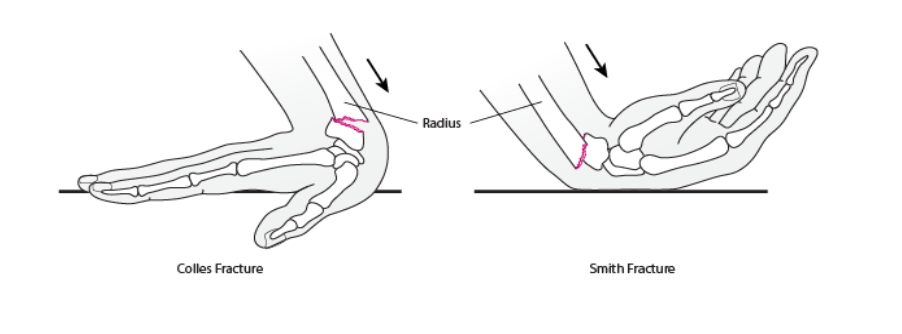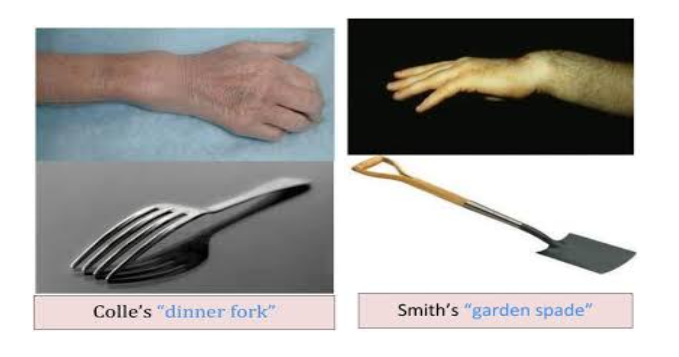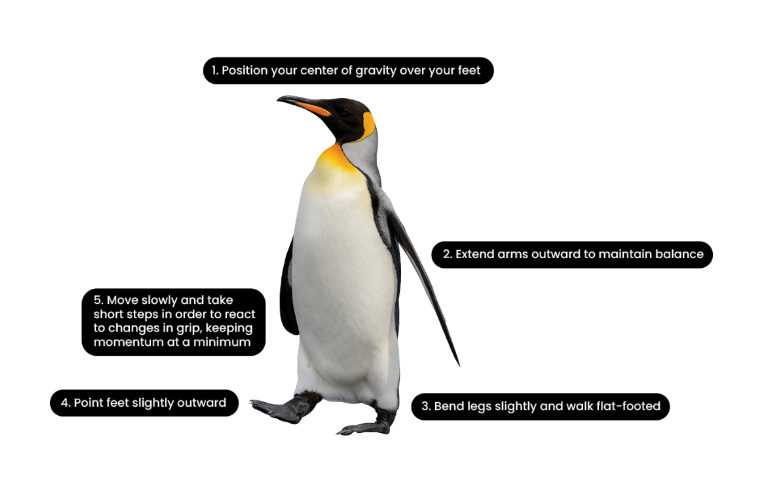Written by Vanessa Mahoney, MBA, BS, LAT, ATC
As the colder weather approaches, it is important to be mindful of the terrain where ice could be possible, and that slips and falls are prevalent during this time. When one falls, such as on ice, it is common to land on an outstretched hand in order brace yourself. When this occurs, the likelihood of a wrist fracture is a possibility. Colles and Smith fractures are types of fractures you may see at the wrist joint when falling on an outstretched hand.
 Colles fractures can occur from a fall when you land on the palm side of your hand. The radius bone (the bone closer to your thumb) breaks, pointing toward the back of the hand. Symptoms include pain, swelling, bruising, tenderness, and a deformity that can make the wrist look crooked. The clinical appearance may resemble a dinner fork (see picture below).
Colles fractures can occur from a fall when you land on the palm side of your hand. The radius bone (the bone closer to your thumb) breaks, pointing toward the back of the hand. Symptoms include pain, swelling, bruising, tenderness, and a deformity that can make the wrist look crooked. The clinical appearance may resemble a dinner fork (see picture below).
On the other hand, Smith fractures occur from falling on the back side of your hand/wrist, and the radius bone breaks, pointing toward the palm side of the wrist, or volarly. Symptoms include pain, swelling, a visibly displaced fragment, and loss of movement. The clinical appearance of a Smith fracture may resemble a garden spade (see picture below).
 Treatment of Colles and Smith fractures will depend on whether the fracture is displaced (meaning it’s out of place), the age and activity level of the patient, the physician/surgeon’s preference in treatment method, and the patient’s concerns regarding immobilization and return to activity. These types of fractures are, unfortunately, common, therefore, many methods of treatment have been developed in order to stabilize the fractures and allow the bone to heal. It is important to ensure the wrists function returns to normal after healing.
Treatment of Colles and Smith fractures will depend on whether the fracture is displaced (meaning it’s out of place), the age and activity level of the patient, the physician/surgeon’s preference in treatment method, and the patient’s concerns regarding immobilization and return to activity. These types of fractures are, unfortunately, common, therefore, many methods of treatment have been developed in order to stabilize the fractures and allow the bone to heal. It is important to ensure the wrists function returns to normal after healing.
Non-Displaced Fracture
If the fracture is not displaced and pain is minimal, a simple splint may be used to immobilize the area. This method is most frequently seen in elderly, low activity level patients. In young, active patients, a plaster cast is usually placed to ensure immobilization and proper healing.
Minimally Displaced Fracture
If the fracture is minimally displaced, the surgeon may manually move the bones back in place in a procedure called “closed reduction”. This procedure is followed by a plaster cast for 6 weeks.
Displaced Fracture
Surgery is indicated for displaced fractures, or fractures that are unstable and fail closed reduction. One type of surgical technique that is available is a closed reduction procedure with percutaneous pinning. Pins are inserted into the site of the fracture and manipulated to realign the bones. The pins are ultimately used to stabilize the fracture and are removed after the fracture has successfully healed.
Wrist fractures are common, especially during the cold winter season. To help avoid these injuries during months of ice and snow, it’s important to consider to “walk like a penguin.” “Walking like a penguin” lowers your center of gravity and helps be steadier on our feet. Want to learn how? See below!
 Schedule an Appointment with JAG PT
Schedule an Appointment with JAG PT
Experiencing wrist pain? Schedule an appointment with JAG Physical Therapy to start your personalized recovery plan today!
